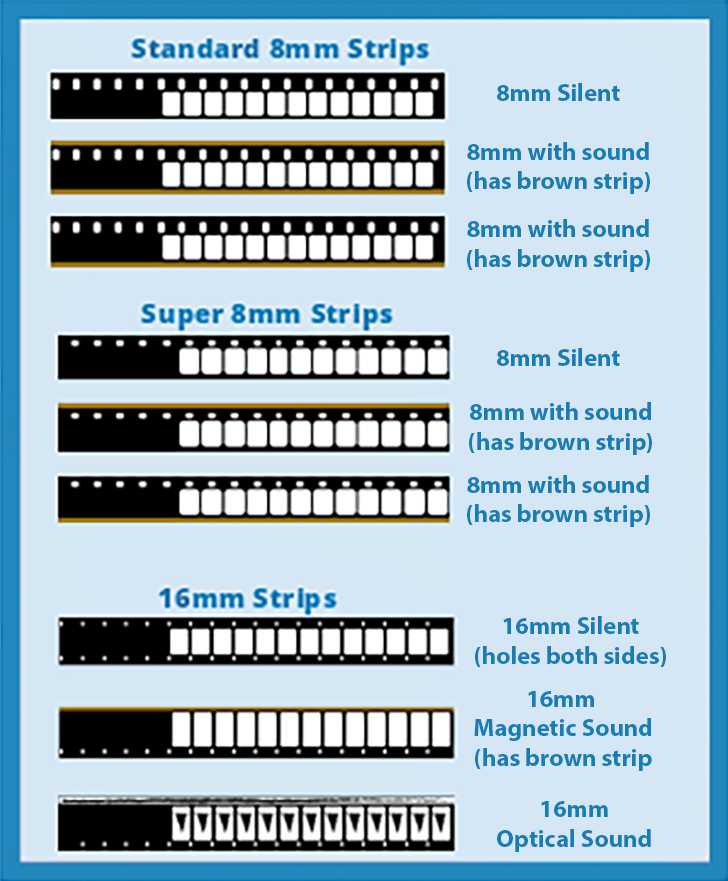Frequently Asked Questions
Films & Movies
We use the latest digital scanning Cine technology to create a digital file for each reel of movie film we transfer. Separate reels of film can be joined together to make one continuous video for showing purposes.
Unfortunately, even the best storage facilities cannot prevent the inevitable deterioration of movie footage. Factors which might impact on the quality of old film include:
This list is by no means comprehensive. Films begin to deteriorate slowly as soon as they are created. The only way to ‘stop the rot’ is to have them digitally transferred as soon as you are able.
Probably not. It was an expensive product, and only became more popular towards the end of the life of the technology.
Please check this chart to see if your film type appears. A brown ‘magnetic; strip on the edge indicates the possibility of sound.

Yes. If we find any of your film reels include sound, we will digitise that and sync it to the pictures and include it in your final product. This requires a second procedure on these film reels incurring a small additional charge. Please check with our customer service professionals for full details.
Yes, if your 16 mm film reels have optical soundtracks we are able to provide you with a fully digitised and synchronised audio with your pictures. This requires a separate additional procedure which incurs a small additional charge. Please check for details.
Sorry, but at this stage we do not provide that service.
Today’s video is measured in minutes, seconds and frames. Movie footage was (and still is) measured in feet. Old super 8 film cameras used small cartridges that shot 50 feet of film (Approximately 3.5 minutes of recording time). You could then join these smaller reels together to make long-running movies. The most frequently seen reels are 13cm diameter (200 feet) and 15cm diameter (400 feet) reel sizes. Sometimes the reels were not totally full. You can read how much footage you have on the measuring gauge on the side of the plastic reel itself.
Photo Scanning
Yes, absolutely. All digital photo files can be enhanced. Most home computers have a limited capacity to tweak the colour, brightness and contrast of digital photos, or you can buy and download various sophisticated professional software apps, some of which are free.
Our standard procedure is to apply a light colour correction on bulk scanned images, however we do not offer a detailed service at bulk scanning prices.
Shipping
Please allow sufficient to store all your material
Video: 1.5 GB for each hour of video
Film: 300 MB per 100 foot of film
Still photos: 10 mb per image
Yes, after our processes have been completed, your videos are now stored as MPEG4 digital files. There are a number of great editing systems available, some of them free, and others requiring the purchase or a subscription. Please note that it is often easier to edit files if they are stored on a USB Hard drive than from a DVD, which is better purely as a storage and playback medium.
DVDs
Yes, after our processes have been completed, your videos are now stored as MPEG4 digital files. There are a number of great editing systems available, some of them free, and others requiring purchase or a subscription. Please note that it is often easier to edit files if they are stored onto a USB Hard drive than from a DVD, which is better purely as a storage and playback medium.
DVDs store Standard Definition video files that 576 pixels high and 1024 pixels wide in widescreen format, or 768 in 4:3 format. The files are stored in a folder named Video TS and typically have a. VOB extension.
We will default supply your transfers onto a Hard Drive (USB) as this maximises the ease of transfer, copying, editing and uploading. We will supply you with a Hard Drive from our stock unless you prefer to provide us with one of your own. DVD copies are available at an additional cost.
We transfer your film or video footage to MPEG4 files, using the universal H264 codec. This allows your video files to be viewed on both PC and Mac, as well as Smart TVs in all countries of the world.
All files such as photos, films, negatives and video will be transferred into digital files and stored as separate files on a USB hard drive. Additionally, DVD copies are available at an additional charge.
We will add the cost of a USB Hard drive to your invoice unless you prefer to provide us with one of your own.
There are a number of different ways to do this depending on the editing software you are using. Many editing systems provide for you to import files directly from a DVD to your computer or a nominated folder in an external hard drive.
Click on the DVD icon, and it will open a folder, showing you a sub-folder named VIDEO_TS. Inside this folder are a variety of files in a file format “container” with a VOB extension.
Locate the files named:
vts_01_01.vob
vts_01_02.vob
etc..
They will be large files and split into approx 1GB file sizes.
Copy these files to your hard drive or computer.
Go into your hard drive and change the FILE EXTENSION from .VOB to .mpeg (and rename your files if you wish)
You now have your files on your hard drive in MPEG2 format ready to play or edit.
Some software will also allow you to convert these files to MPEG4 files.
Yes, provided that you have a DVD burner and appropriate DVD burning software. We do not apply copy protection to your DVDs. We suggest the use of blank DVD-R discs.
Timing
Depending on our current workload we estimate that the majority of orders will be completed within 1-3 weeks of receiving your order. Smaller orders can to take between 1-3 days, whilst very large jobs can take at most 5-6 weeks. Express Services are also available. While we undertake to do our best to meet this time frame, or where possible better it, please understand that cannot be guaranteed due to the number of possible technical complications that may arise.
The length of time to complete a job depends on how many orders are in the pipeline ahead of yours. We also complete all our orders individually, loading and correcting the source material by hand. This is a highly skilled and technical process that can involve multiple passes of your material in real-time so that 10 hours of videotape can take over 10 hours to digitise. We do not compromise on quality with your precious family memories.
When your tapes, films or photos are required to be digitised by a deadline that is faster than our standard service, you might be interested in our priority fast-tracking service, For an extra fee, your order will be able to be attended to straight away and returned to you quickly. Please discuss this with one of our friendly and professional customer service operators. Please also make sure you discuss this prior to the commencement of your order.
Troubleshooting
Many late model computers and lap tops do not feature a DVD slot or playback capability. An external DVD player is available for purchase for most computers. MP4 files are played back through internal computer software, such as VLC, Windows Media Player or Quicktime. You may need to download appropriate software if it does not already exist on your computer.
Video Tapes
The simple answer is no. This is because there is no short cut to sitting and watching all the material provided by you, and then comparing various sequences to see if they are the same or not. Although it is not a part of our regular service, we can make a special arrangement to perform this additional service for you on request. Please note it is cheaper for you to check the tapes yourself before giving them to us, or simply request that we transfer the lot.
Yes, we will check your tapes to ensure it is your home movie footage, and not old TV programs recorded off air. Should we find you have provided us with old recorded programming material, we will not transfer that footage, but we will charge you a nominal tape checking fee.
Yes, we can. Should any of your old movie footage be recorded in NTSC we can convert and transfer it to MP4 files or PAL DVDs at no additional cost.
Our default is to only transfer your old home footage, but should you have specific programming recorded from TV to videotape ‘off air’ that you would also like to have transferred, then yes, we can do that.
The answer is yes. Should we discover any of your tapes have included footage that is recorded off air, we will not include that with your transferred files. We do not delete or edit your home movie footage.
Most common types of damage do not prevent us from being able to extract footage for transfer. If we discover severe damage or issues that would seriously compromise the quality of the end product (visual or audio), we will contact you and provide a report. We then give you the option of not transferring that tape or film, or to proceed anyway.
No, we do not. This method produces an inferior, highly compressed end product that is not truly ‘future-proofed’. The more recently developed MP4 format has become universally accepted and will playback on all modern Macs, PCs and Smart TVs. We digitise your footage at the highest uncompressed level, then use that file to create your DVDs or MP4 files. This produces a far better end product both visually and audio-wise.
For the most part, this should not be a problem. The ravages of time are not kind to videotape. The plastic polymer stretches, the magnetised oxide particles can stop adhering to the tape, and your tapes might also have suffered some damage from rough play heads or cartridge malfunctions. All this can result in parts of your footage incorporating some unavoidable scratchiness or jumpiness.
Payment
Yes, we check your old tapes. If they have old family footage or home videos, we will put them into our system to be transferred. If on the other hand, we discover they contain old TV programs recorded from ‘off-air’, we will charge you a $5 service fee for our time.
When your job is complete, we will issue you with an invoice. You can pay.
-Credit card (Visa, Mastercard and Amex)
-Direct transfer (EFT) from your cheque or savings account

